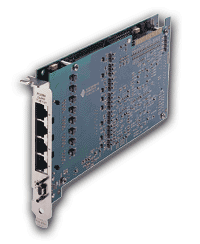
PCI384
Quad T1/E1/J1 Telecom Adapter

As Next-Generation IP networks become a reality, the need for high density and high performance access for new telecom and IP telephony systems becomes critical. The PCI384 addresses these needs by providing telecom OEMs and integrators with a high density, highly advanced connectivity subsystem.
The PCI384 is ideally suited for both PSTN and IP telephony systems handling large volumes of voice circuits for protocol processing or for transfer to the H.100 bus and the PCI bus. Application examples include SS7 network elements, wireless infrastructure equipment, media and signaling gateways, and telecom switching and routing equipment.
The PCI384 is an adaptable platform designed with an onboard MPC8260 PowerQUICC®II RISC communications processor. Combined with an embedded Linux operating system the PCI384 operates as a fully programmable communications subsystem capable of intra-chassis communication using the H.100 bus.
| Quad T1/E1/J1 Communications Interface for PCI Systems | Ideal for high density voice/data apps in IP telephony systems |
| Software Programmable Interfaces | Independently software programmable on receive and transmit termination |
| Motorola MPC8260 PowerQUICC®II Processor | Integrated communications functionality managed by an MPC603e PowerPC core |
| H.100 Bus Support | Capable of switching 96/128 time slots bi-directionally to any of the 4096 H.100 CT bus channels |
| NexusWare™ Development Environment | Embedded Linux OS manages all onboard functions & offers an open API for development |
| 128MB Dedicated Processor DRAM Memory | Handles extensive onboard traffic and protocol requirements |
| ˇ@ | ˇ@ |
The architecture of the PCI384 capitalizes on the Motorola MPC8260 PowerQUICCII Processor. The advanced feature set of the MPC8260 allows for superior handling of 4 fully channelized T1/E1/J1 spans, increasing the number of possible active protocol links.
The PCI384 also supports the ECTF H.100 specification. By incorporating the H.100 interface device, the PCI384 can send or receive any of its possible time slots to the front panel. The PCI384 can switch all 128 of its DS-0 channels to any of the 4096 H.100 CT bus channels.
Other features include 128MB of DRAM allowing the PCI384 to execute protocols and WAN applications directly onboard. It also provides a monitor port and console port for upgrades and management.
The PCI384 is enabled with the Linux-based NexusWare™ development environment. Due to the wide acceptance and extensive number of publicly available applications and protocols, system developers can bring sophisticated systems to market in a much shorter time.
With a well-defined API, the integrated protocol suite from Performance Technologies reduces time to market by eliminating unnecessary development time at the hardware/protocol level. The protocols for our standard WAN hardware products enable development engineers to proceed directly to integration and application development.
Performance Technologiesˇ¦ suite of WAN communications protocols provides complete WAN connectivity solutions for SS7, Channel7™ MTP-2, Frame Relay, HDLC, LAPD, X.25, and PPP protocols. OS support includes Solaris, Linux, and WindowsNT.
For the Solaris environment, Performance Technologiesˇ¦ ChanneLink™ Communications Software provides both a transparent link to all SunLink™ protocols, as well as a documented set of driver primitives for developing T1, J1 or E1 related applications.
| Interface | 4 RJ48C interfaces that are independently software programmable on
receive and transmit termination. Operating modes supported are:
1 Micro DB 9 interface supporting: |
| Processor | Motorola MPC8260 PowerQUICC®II (MPC603e core) 64 bit data and 32 bit address bus |
| Framing Standards | D-4, ESF, DS-1, PRI; AMI/B8ZS Line encoding |
| Memory | 128MB dedicated DRAM 16MB flash PROM 256KB COM Memory (high speed local memory) |
| Specification Compliance | PCI Revision 2.2 ECTF H.100 Compliant ANSI T1. 102-1993 IEEE 802.3 |
| Physical Interface | T1/E1/J1: Four RJ-48C Connectors Monitors: One Micro DB 9 |
| Protocol Support | SS7, Channel7 MTP-2, HDLC, Frame Relay, LAPD, X.25, PPP Optional NexusWare, Linux-based development environment |
| Agency Certifications | FCC Class A, CE, UL 1950 (pending), NEBS Level 3 friendly |
| MTBF | > 200,000 power-on hours (POH) |
| Power | 11 watts maximum (2.2A @ +5.0V) 9.5 watts idle (1.9A @ +5.0V) |
| Dimensions | PCI short form, double card |
| Temperature | Operating: 0˘X to 50˘X C (32˘X to 122˘X F) Non-operating: ˇV20˘X to 80˘X C (ˇV4˘X to 176˘X F) |